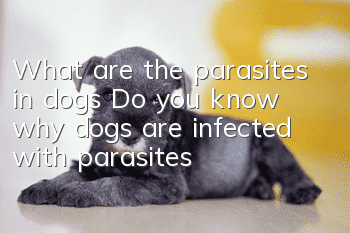What are the parasites in dogs? Do you know why dogs are infected with parasites?

Ascariasis in dogs
1. Symptoms: Gradual weight loss, pale mucous membranes. Loss of appetite, vomiting, heterophilia, digestive disorders, first diarrhea and then constipation. Epileptic spasms are occasionally seen. Puppies have enlarged abdomens and delayed growth. When the infection is severe, roundworms are often excreted in the vomit and feces, which can prove ascariasis.2. Reason: Ascaris eggs are excreted in the feces and develop into infectious eggs under suitable conditions.
①: After puppies under 3 months old swallow infective eggs, larvae hatch out in the intestines. The larvae penetrate into the intestinal wall, pass through the lymphatic system to the mesenteric lymph nodes, and then reach the liver through the blood stream, and then follow The blood flow reaches the lungs, and the larvae pass through the alveoli, bronchioles, and bronchi, and then are swallowed into the stomach through the larynx. They further develop into adult worms in the small intestine. The whole process takes 4-5 weeks.
②: After adult dogs swallow infective eggs, the larvae travel to various tissues and organs of the body with the blood flow and form cysts. The larvae remain active but do not develop further. After the female dog with cysts in her body becomes pregnant, The larvae are activated and migrate through the placenta to the fetal liver causing intrafetal infection. After the fetus is born, the larvae migrate to the lungs, and then migrate to the gastrointestinal tract to develop into adult worms. Mature canine roundworms appear 23 to 40 days after the birth of the puppies. Newborn puppies can also become infected by sucking colostrum. After infection, the larvae develop directly into adult worms in the small intestine.
3. Measures: Regular deworming, puppies need to be checked once a month, and adult dogs need to be checked every three months.
①Drugs: Take levamisole orally at 10mg/kg body weight. Or take mebendazole, 10mg/kg body weight, 2 times/day for two days. Or take 5-10mg/kg body weight of pyrantel (anti-insecticide) orally. Or take 100mg/kg body weight of piperazine citrate (Chulanling) orally.
②Hygiene: Timely disinfection is required. The environment, tableware, and meals need to be cleaned well. The hygiene of the kennel, including cleaning and feces cleaning, needs to be timely.
Hookworm disease in dogs
1. Symptoms: When severely infected, the mucous membranes will be pale and thin, and the coat will be thick, dull, and easy to fall off. Loss of appetite, heterophilia, vomiting, digestive disorders, alternating episodes of diarrhea and constipation. The feces may be bloody or black, and in severe cases may be tar-like, with a rancid smell. If a large number of larvae invade through the skin, the skin will become inflamed and itchy. Some limbs may be swollen and later ulcerated, or the corners of the mouth may be eroded. Puppies under 3 weeks old that are infected with hookworm in the womb or colostrum can cause severe anemia, leading to coma and death.2. Cause: The common pathogens causing canine hookworm disease are Ancylostoma caninum and Ancylostoma ancylostomycetes.
①: Hookworm eggs are excreted with the feces. Under suitable conditions, the larvae (rod-shaped larvae) hatch out in 12 to 30 hours. After about 1 week, they transform into infective larvae (sheathed filamentous larvae). ). Dogs are usually infected through the mouth, but can also be infected through the skin and oral mucosa.
②: When the larvae enter the host body through the mouth, they stay in the intestine, take off the sheath, and gradually develop into adult worms. When the larvae invade through the skin, they burrow into peripheral blood vessels, migrate to the alveoli and trachea, enter the mouth with sputum, and develop into adult worms in the small intestine after swallowing. Canine hookworm can also be infected through the placenta and colostrum. The life history of Ancylostoma stenoceicus is similar to that of Ancylostoma canis, but oral infection is more common.
3. Measures:
① Drugs: The commercial preparation is 4.5% diiodonitrophenol solution, and the dose of one subcutaneous injection is 0.22 ml (10 mg) per kilogram of body weight. It is effective for various diseases of dogs. Hookworm repellent effect is close to 100%. This medicine is not effective against canine roundworms, whipworms, tapeworms, and paragonimiasis. In addition, levamisole, mebendazole, and pyrantel can also be used to anthelminize. For dosage and usage, please refer to Canine Ascariasis. Severe anemia requires symptomatic treatment, oral or injected iron-containing supplements or blood transfusions.
②Hygiene: The kennel should be kept clean and dry, and feces should be cleaned up in time. Pour boiling water on the wooden parts of the cage, and burn the iron parts or the floor with a blowtorch. Moveable utensils can be moved outdoors and exposed to the sun to kill insect eggs.
Taeniasis in dogs
1. Symptoms: Except for the occasional discharge of mature proglottids in sick dogs, mild infection is usually unnoticeable. Severe infection may cause abnormal appetite (bulimia, heterophilia), vomiting, chronic enteritis, alternating diarrhea and constipation, anemia, weight loss, easy agitation or depression, and some may cause spasm or limb paralysis. When the worms form into clumps, they can block the intestines, leading to acute abdominal diseases such as intestinal obstruction, intussusception, volvulus, and intestinal rupture. 2. Reason: The body is light red and 10-50 cm long. Mature body segments are 7 mm long, 2-3 mm wide, elongated oval, and look like cucumber seeds. Each mature segment contains two sets of male and female reproductive organs, with the genital pore opening in the center of both sides of the segment. Fleas and hairlice are the intermediate hosts of dog tapeworms, in which they develop into cysticerci-like cysts. The final host becomes infected by ingesting a flea or tick containing cysticerci, which develop into adult worms in the small intestine in about 3 weeks.
3. Measures:
① Drugs: Use arecoline hydrobromide at a dosage of 1.5-2mg/kg body weight, orally. Make the sick dog fast for 12-20 hours and then administer the drug. In order to prevent vomiting, dilute iodine tincture (10 ml of water, two drops of iodine tincture) should be given 15-20 minutes before taking the medicine. Or use praziquantel, the dosage is 5-10 mg/kg body weight, once orally. Or use butamidine hydrochloride at a dosage of 25-50 mg/kg body weight, once orally, to expel Echinococcus granulosus, use 50 mg, and then use it once every 48 hours.
②Hygiene: Preventive deworming should be carried out 4 times a year (once per quarter), and breeding dogs should be carried out 3 to 4 weeks before breeding. When deworming, the dog should be isolated within a certain range so that the excreted worms and feces can be collected and completely destroyed to prevent the spread of pathogens. Properly dispose of slaughtering waste to prevent dogs from eating meat containing tapeworm larvae.Keep the kennel and the dog's body clean, regularly use insecticides to kill fleas and lice on the dog's body, and eliminate rodents.
Toxoplasmosis in dogs
1. Symptoms: Most are asymptomatic latent infections. Infections are more common and the symptoms are more severe in puppies and young dogs, and fatal cases have also been reported in adult dogs. Symptoms are similar to canine distemper and canine infectious hepatitis. The main symptoms are fever, cough, anorexia, lethargy, weakness, secretions from the eyes and nose, pale mucous membranes, difficulty breathing, and even severe bloody diarrhea. A few sick dogs have severe vomiting, followed by paralysis and other neurological symptoms. When a pregnant female dog suffers a miscarriage or premature birth, the puppies often have symptoms such as loose stools, difficulty breathing, and ataxia. Blood tests show that in the acute phase, red and white blood cells decrease and neutrophils increase. Neutropenia and monocytosis are less common. The total number of white blood cells in chronic cases increases, mainly neutrophils, and thrombocytopenia, but there is no bleeding tendency.2. Reason: The pathogen of toxoplasmosis is Toxoplasma gondii, referred to as Toxoplasma gondii. It requires two hosts for its entire development. Cats are the ultimate host of Toxoplasma gondii. In the epithelial cells of the cat's small intestine, schizophrenia and gametogenesis similar to the development of coccidia are carried out. Finally, oocysts are formed and excreted with cat feces. The oocysts undergo spore proliferation and development in the external environment. An infective oocyst containing two sporangia. If a dog accidentally eats cat feces, it is very easy to be infected with toxoplasmosis.
3. Measures:
① Drugs: For acute infection cases, sulfadiazine (SD), 70 mg per kilogram of body weight, or trimethoprim (TMP), 14 mg per kilogram of body weight can be used , taken orally twice a day for 3-4 days. Due to the low solubility of sulfadiazine, it is easier to precipitate crystals in urine. When taking it orally, it should be mixed with an equal amount of sodium bicarbonate and drink more water. In addition, sulfonamide-6-methoprim (sulfamethoprim, sulfamethoxazole, SMM, DS-36) or sulfonyl dapsone (SDDS) can be used.
Random articles
- What causes dogs to bark? Do you know what to do to prevent dogs from barking?
- What should you pay attention to when neutering your dog? What should you pay attention to when neutering your dog?
- How to judge the appearance of Tibetan Mastiff and teach you how to choose Tibetan Mastiff
- Which brand of dog food is good? Do you know how to choose dog food for your dog?
- How to tell if there are worms in your dog’s body? Do you know how to deworm them?
- Do you know the eight reasons why dogs cannot be bathed?
- How to bathe Teddy? Teddy’s hair care
- How many months does it take for a Xiasi dog to be pregnant? How long does it take from pregnancy to delivery for a Xiasi dog?
- How to choose a dog leash How to set a leash
- When is the best time to neuter a Poodle? What are the benefits and disadvantages of neutering a Poodle?



